(Page 2 of 3)
 |
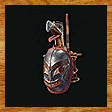
[ closed ]
[ half-open ]
[ open ]
|
A complex transformation mask. Closed, the mask depicts a Whale with a seagull on its head. When the Whale's face is opened, the dorsal fin and gull's head both fold back to reveal the humanlike inner face. Copper eyebrows, lips and cheek decorations complete this mask.
Collected on Haida Gwaii in 1879 by Israel W. Powell.
CMC VII-B-23 (S92-4172 closed, S92-4174 open) |

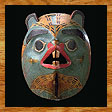 |
The relatively small upper incisors of this Marmot mask and the lack of a stick in its mouth distinguish it from a Beaver. Collected by Alexander McKenzie of the Hudson's Bay Company, who commented it was used in a social dance at a house-warming potlatch in Masset before 1884.
CMC VII-B-136a (S85-3277) |

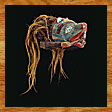 |
This forehead mask represents a Beaver characteristically gnawing a stick, which it holds with humanlike hands. There is abalone shell inlay on the teeth and eyes, and streamers of human hair. Some Tsimshian influence is evident in the form and decoration of the eyebrows.
Collected on Haida Gwaii in 1879 by Israel W. Powell.
CMC VII-B-17 (S92-4168) |

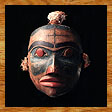 |
This dance mask dating from about 1860 has unusual red eyes, with peepholes beside each pupil rather than in the centre of them, lending a blank or neutral expression to the face. Red cedar bark and eagle down are still attached.
Collected on Haida Gwaii by Israel W. Powell in 1879.
CMC VII-B-4 (S92-4161) |

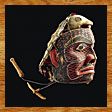 |
A dance mask with a movable attachment of a White Squirrel on top. The style is markedly Tsimshian, including the dashed and crosshatched zones on the face, as well as the White Squirrel crest. Masks like this one were probably acquired by the Haida in trade at Fort Simpson.
Collected on Haida Gwaii in 1879 by Israel W. Powell.
CMC VII-B-21 (S92-4171) |

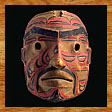 |
A mask with unusually large eyeholes, peaked eyebrows and thick lips. The extensive face painting on it is crudely done and gives no indication of what it represents.
Collected on Haida Gwaii (probably at Skidegate) in 1879 by Israel W. Powell.
CMC VII-B-135 (S92-4195) |

|